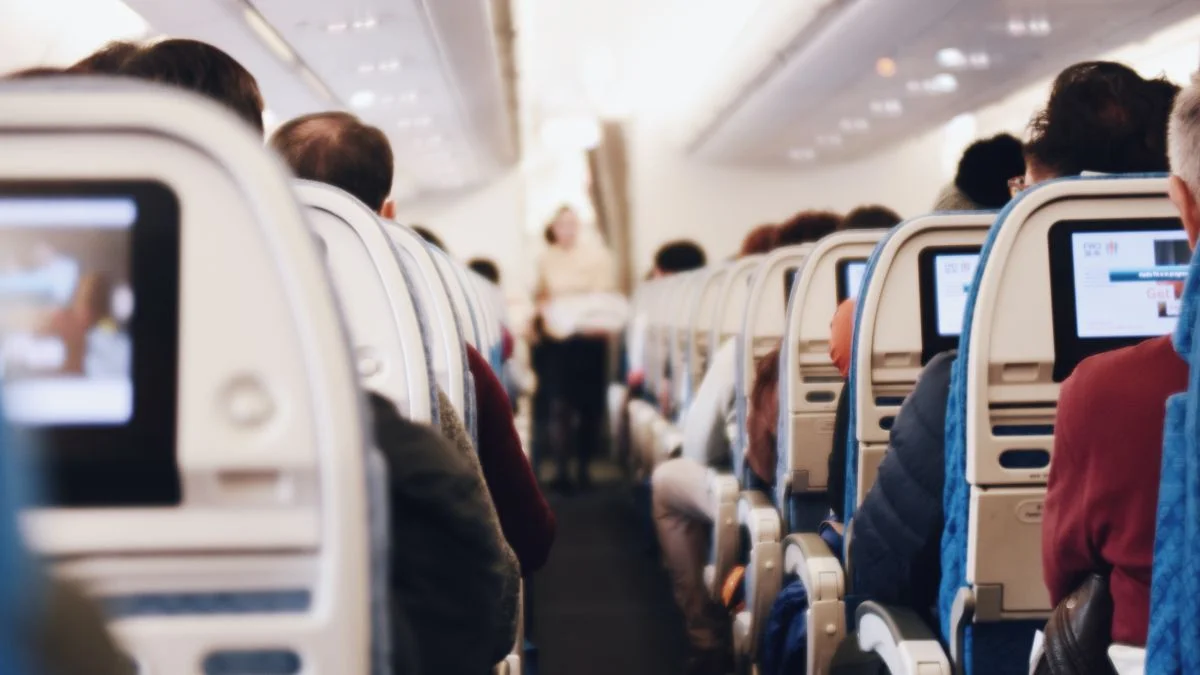How Full Is Your Flight? Here’s How to Check It Out

As participants in Amazon Associates and other programs, we earn from qualifying purchases. This comes at no additional cost to you. For more details, see our Affiliate Disclosure.
In today’s age of air travel, knowing how packed your flight might be is not just a matter of comfort, but often of safety and peace of mind. Whether you’re hoping for an empty seat next to you or you’re simply being cautious in crowded times, checking the fullness of your flight can be immensely beneficial.
HIGHLIGHTS:
- Checking a flight’s occupancy is possible through airline websites or customer service.
- Third-party tools and websites offer alternative methods to determine how full a flight is.
- Knowing a flight’s occupancy can inform decisions about seating, boarding, and overall travel strategy.
- Overbooking is a common airline practice, and understanding its implications can help travelers prepare for potential disruptions.
In this article, we’ll guide you through the steps and tools to find out just how full your upcoming flight is.
Here’s How to Check How Full Your Flight Is
In the bustling realm of air travel, determining the occupancy of your flight can greatly influence your overall experience. From deciding on seat upgrades to simply ensuring a more peaceful journey, being informed is essential. Here are some concise steps to help you gauge just how packed your flight might be.
Airline’s Official Channels: Most airlines offer real-time seating charts on their official websites. Once you’ve booked a ticket, logging into your reservation will often show a seat map, giving you a glimpse of taken and available spots.
Customer Service: Sometimes, the direct approach works best. A quick call to the airline’s customer service can provide a straightforward answer. They have up-to-date information and can inform you about the current occupancy level of your flight.
Mobile Apps: Several airlines have their own mobile apps which often include detailed flight information. Beyond just checking in, these apps can provide live updates on seat availability, making it easier for travelers to stay informed on the go.
Third-party Platforms: Websites like FlightAware or SeatGuru not only offer insights into flight paths and timings but also sometimes provide details on flight fullness. Additionally, frequent flyers often share experiences and tips on travel forums which can be a valuable resource for occupancy insights.
In our modern age, with a myriad of tools and resources at our fingertips, staying updated on flight details is more accessible than ever. It just takes a bit of proactive searching to make your journey as comfortable and strategic as possible.
Checking with the Airline Directly
Checking with the airline directly is one of the most straightforward methods to determine the occupancy of a flight. Airlines have robust systems in place to manage bookings, and they can provide the most accurate and up-to-date information.
Many airlines’ official websites allow passengers to view seat maps for specific flights. By logging into your reservation, you can often see a visual representation of which seats have been occupied and which remain available. This provides a clear snapshot of how full the flight might be.
Another reliable method is to simply pick up the phone and call the airline’s customer service. The representatives have real-time access to flight details and can quickly inform you about the current occupancy or the number of seats left.
Additionally, the age of smartphones has seen many airlines introduce dedicated mobile apps for their customers. Beyond the basic functionalities of booking and check-in, these apps often allow you to view seat maps and occupancy, offering another handy avenue to stay informed on the go.
Third-party Tools and Websites
In today’s interconnected world, third-party tools and websites have emerged as invaluable resources for travelers seeking insights beyond what airlines directly provide. These platforms offer a range of information, including flight occupancy details.
One popular platform many travelers turn to is SeatGuru. This site provides comprehensive details about different aircraft, including seating charts and reviews. By cross-referencing flight details with the seating maps on SeatGuru, passengers can get an idea of how full a flight might be.
FlightAware is another powerful tool, mainly known for its real-time flight tracking capabilities. While its primary focus is on flight paths and timings, savvy travelers often glean occupancy insights based on the type of aircraft and other shared details.
Travel forums and communities, like FlyerTalk, are also gold mines for information. Frequent flyers and travel enthusiasts share their experiences, tips, and sometimes even real-time updates on specific flights. By browsing these forums, one can often find anecdotal evidence or direct insights about flight occupancy.
Why It’s Useful to Know Your Flight’s Occupancy
Knowing your flight’s occupancy isn’t just about satisfying curiosity; it carries practical implications that can significantly impact your travel experience. Here’s why this piece of information can be particularly useful:
Comfort and Personal Space: Flights that aren’t fully booked might have empty seats or even entire rows. This knowledge can allow you to strategically choose or switch to a seat where you might have more space to stretch out or avoid a cramped feeling, especially on longer flights.
Health and Safety Considerations: In a post-pandemic world, travelers have become more health-conscious. Knowing the occupancy can help individuals assess their comfort level with the crowd size, especially if they’re trying to maintain social distance.
Strategic Planning for Upgrades: If you’re eyeing a seat upgrade, knowing how full the economy or business class is can be instrumental. Flights that aren’t packed might have last-minute upgrade options available, sometimes even at a reduced price.
Luggage Overhead Space: A packed flight can mean limited overhead bin space for carry-on luggage. If you’re aware that a flight is nearing full capacity, you might decide to check in a bag or board earlier to secure space for your belongings.
Potential Delays and Overbooking: Airlines sometimes overbook flights, anticipating a few no-shows. If a flight is overbooked and everyone shows up, it can result in delays or the need for volunteers to change their travel plans. Knowing the occupancy can give you a heads-up about such potential situations.
In-Flight Service and Amenities: On less occupied flights, in-flight services like meals or amenities might be more abundantly available, whereas a full flight could mean limited choices or quicker run-outs of specific meal options.
Understanding your flight’s occupancy can empower you to make informed decisions, ensuring a smoother, more comfortable travel experience.
What Happens If a Flight Is Overbooked and No One Volunteers?
Overbooking is a common practice in the airline industry, based on statistical predictions of no-shows. But on occasions where all passengers show up, it presents a challenge. If a flight is overbooked and no one volunteers to change their plans, the following scenarios typically unfold:
Involuntary Denied Boarding: Airlines have the right to deny boarding to passengers involuntarily. If this happens, they must provide an explanation for their selection criteria, which can be based on factors like check-in time, fare type, or frequent flyer status.
Compensation: Passengers who are involuntarily denied boarding due to overbooking are typically entitled to compensation. The nature and amount of compensation depend on the airline’s policies, local regulations, and the duration of the delay the passenger will face.
Alternative Arrangements: Airlines are responsible for making alternative travel arrangements for passengers denied boarding. This could mean booking them on the next available flight, routing them through another airline, or even providing accommodations if an overnight stay is required.
Additional Amenities: To ease the inconvenience, airlines may also offer affected passengers amenities like meal vouchers, access to airport lounges, or even additional miles for their frequent flyer accounts.
While overbooking can create initial disruption, regulations and airline policies ensure that affected passengers are compensated and accommodated as swiftly as possible.
Can Airlines Kick You Off a Flight If Overbooked?
Yes, airlines can deny boarding to passengers on overbooked flights, even if those passengers have a confirmed ticket. This practice is based on statistical calculations that anticipate a certain number of no-shows. However, when more passengers show up than there are seats available, some may be asked or, in extreme cases, involuntarily denied boarding.
If a passenger is involuntarily denied boarding due to overbooking, airlines are generally obligated to compensate them. The type and amount of compensation, as well as the criteria for selecting which passengers are denied boarding, vary based on airline policies and local regulations. Additionally, airlines must arrange alternative travel options for affected passengers to reach their destination.
Who Gets Bumped First on an Overbooked Flight?
Who gets bumped first on an overbooked flight often depends on the airline’s specific policies and criteria. Typically, passengers with the lowest fare classes, those who checked in last, or those without a seat assignment are more likely to be bumped first. Conversely, elite members of an airline’s loyalty program, those with higher fare tickets, or passengers with special needs usually receive priority and are less likely to be denied boarding.
It’s important to note that each airline may have its own set of rules and priorities when determining who gets bumped. Some might consider factors such as frequent flyer status, the time of ticket purchase, or even the purpose of travel. Regardless of the criteria, airlines are generally required to explain their selection process if passengers are involuntarily bumped due to overbooking.
Do Airlines Pay Cash for Overbooking?
Yes, airlines can offer cash compensation to passengers who are involuntarily denied boarding due to overbooking. The amount of compensation varies based on several factors, including the length of delay the passenger will experience in reaching their final destination, the fare they paid, and local regulations governing air travel.
However, it’s important to differentiate between cash and other forms of compensation. While cash is a direct form of payment, airlines often initially offer passengers travel vouchers, discounts, or service credits as compensation. It’s up to the passenger to accept these or request cash instead.
Depending on the jurisdiction and airline policy, passengers might have the right to insist on cash compensation, but it’s essential to be familiar with local regulations and rights in such situations.
Last-minute Changes and Flight Dynamics
Last-minute changes and the ever-evolving dynamics of flights can greatly influence a traveler’s experience. Understanding these elements can help passengers navigate the uncertainties of air travel with more confidence and ease.
Last-minute Changes
Airlines can make adjustments to flight details even shortly before departure. These can be influenced by a myriad of factors including operational constraints, weather conditions, technical issues, or crew availability. Such last-minute changes might involve:
- Delays or rescheduling: Sometimes, unexpected technical or logistical issues can delay a flight. While short delays might not disrupt travel plans significantly, longer delays can necessitate changes in connecting flights or even overnight stays.
- Gate changes: Passengers might find themselves redirected to a different gate than initially indicated. While typically occurring within the same terminal, these can sometimes involve significant walks or shuttle rides, especially in larger airports.
- Aircraft swaps: On rarer occasions, airlines might change the type of aircraft servicing a particular route. This can result in a different seating configuration, affecting passengers’ assigned seats.
Flight Dynamics
The actual dynamics of the flight, or how it operates and feels for passengers, can also be influenced by various factors:
- Load factor: This refers to the percentage of occupied seats on a flight. A high load factor means the flight is near its full capacity, potentially affecting overhead storage space and general comfort.
- Crew dynamics: The interaction between cabin crew and passengers can significantly influence the flight experience. Factors like crew fatigue, experience, and training can play a role in service quality.
- In-flight disturbances: Situations like turbulence, unruly passengers, or onboard medical emergencies can affect the flight’s dynamics, requiring adjustments in altitude, speed, or even route.
- Connecting passengers: A significant number of passengers with tight connections might influence the decision to delay a flight slightly, ensuring they make their onward journey.
While air travel is meticulously planned, it remains susceptible to last-minute changes and varying dynamics. By understanding these potential shifts and being flexible, passengers can better navigate the complexities of modern aviation and enjoy a smoother travel experience.
Tips for More Comfortable and Safe Travel
Traveling, especially by air, can be a mix of excitement and exhaustion. Ensuring a journey is both comfortable and safe requires preparation and mindfulness. Here are some tips to help make your travels more pleasant:
1. Dress Comfortably:
Opt for loose-fitting clothes, breathable fabrics, and comfortable footwear. Layers are essential, as temperature variations are common during travel, especially on flights.
2. Hydrate and Eat Right:
Air travel can be dehydrating. Drink plenty of water, avoid excessive caffeine or alcohol, and eat light meals to prevent feeling sluggish or bloated.
3. Use Neck Pillows and Eye Masks:
For those longer flights, a neck pillow can help support your head and neck, while an eye mask can assist in blocking out unwanted light, facilitating better sleep.
4. Noise-Canceling Headphones:
These are invaluable for blocking out engine noise, crying babies, or chatty neighbors, making your journey more peaceful.
5. Follow Security Protocols:
Always be aware of the latest security requirements at airports. This includes permissible liquids sizes, electronics screening, and any specific regional regulations.
6. Carry Essential Medication:
Always keep necessary medicines, prescriptions, and a basic first-aid kit in your carry-on. This ensures you have access to them during the flight or in case of luggage delays.
7. Stretch and Move:
On longer flights, it’s essential to move around periodically. Stretching and walking can prevent issues like deep vein thrombosis and reduce muscle stiffness.
8. Digital Safety:
Use VPNs when accessing public Wi-Fi in airports or hotels. Avoid sharing travel plans on social media in real-time to maintain privacy.
9. Know Emergency Exits:
Whenever you’re on a plane or in a hotel, familiarize yourself with the nearest emergency exits. It’s a small step that can be crucial in emergencies.
10. Respect Local Customs:
Research the places you’re visiting. Being aware of local customs, etiquettes, and safety guidelines can help you navigate unfamiliar territories more smoothly.
11. Stay Informed:
Sign up for travel advisories or alerts from trustworthy sources. This can keep you informed about any sudden changes or disturbances in your travel region.
12. Choose Accommodations Wisely:
Read reviews and ensure that your chosen place of stay adheres to safety standards. If possible, opt for accommodations in well-lit, central areas.
Being proactive and prepared can transform your travel experience. With a mix of practical measures and a positive attitude, you can ensure your journeys are memorable for all the right reasons.






